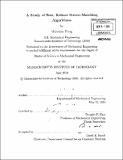| dc.contributor.advisor | Douglas P. Hart. | en_US |
| dc.contributor.author | Hong, Wenxian | en_US |
| dc.contributor.other | Massachusetts Institute of Technology. Dept. of Mechanical Engineering. | en_US |
| dc.date.accessioned | 2011-03-24T20:19:19Z | |
| dc.date.available | 2011-03-24T20:19:19Z | |
| dc.date.copyright | 2010 | en_US |
| dc.date.issued | 2010 | en_US |
| dc.identifier.uri | http://hdl.handle.net/1721.1/61870 | |
| dc.description | Thesis (S.M.)--Massachusetts Institute of Technology, Dept. of Mechanical Engineering, 2010. | en_US |
| dc.description | Cataloged from PDF version of thesis. | en_US |
| dc.description | Includes bibliographical references (p. 115-117). | en_US |
| dc.description.abstract | Stereo matching is an actively researched topic in computer vision. The goal is to recover quantitative depth information from a set of input images, based on the visual disparity between corresponding points. This thesis investigates several fast and robust techniques for the task. First, multiple stereo pairs with different baselines may be meaningfully combined to improve the accuracy of depth estimates. In multibaseline stereo, individual pairwise similarity measures are aggregated into a single evaluation function. We propose the novel product-of-error-correlation function as an effective example of this aggregate function. By imposing a common variable, inverse distance, across all stereo pairs, the correct values are reinforced while false matches are eliminated. Next, in a two-view stereo context, the depth estimates may also be made more robust by accounting for foreshortening effects. We propose an algorithm that allows a matching window to locally deform according to the surface orientation of the imaged point. The algorithm then performs correlation in multiple dimensions to simultaneously determine the most probable depth and tilt. The 2D surface orientation search may be made more efficient and robust by separating into two 1D searches along the epipolar lines of two stereo pairs. Moreover, by organizing the multi-dimensional correlation to avoid redundant pixel comparisons or using numerical minimization methods, greater efficiency may be achieved. Finally, we propose an iterative, randomized algorithm which can significantly speed up the matching process. The key insights behind the algorithm are that random guesses for correspondences can often produce some good disparity matches, and that these matches may then be propagated to nearby pixels assuming that disparity maps are piecewise smooth. Such a randomized algorithm converges within a small number of iterations and accurately recovers disparity values with relative computational efficiency. All three techniques developed are described analytically and evaluated empirically using synthetic or real image datasets to demonstrate their superior performance. | en_US |
| dc.description.statementofresponsibility | by Wenxian Hong. | en_US |
| dc.format.extent | 117 p. | en_US |
| dc.language.iso | eng | en_US |
| dc.publisher | Massachusetts Institute of Technology | en_US |
| dc.rights | M.I.T. theses are protected by
copyright. They may be viewed from this source for any purpose, but
reproduction or distribution in any format is prohibited without written
permission. See provided URL for inquiries about permission. | en_US |
| dc.rights.uri | http://dspace.mit.edu/handle/1721.1/7582 | en_US |
| dc.subject | Mechanical Engineering. | en_US |
| dc.title | A study of fast, robust stereo-matching algorithms | en_US |
| dc.type | Thesis | en_US |
| dc.description.degree | S.M. | en_US |
| dc.contributor.department | Massachusetts Institute of Technology. Department of Mechanical Engineering | |
| dc.identifier.oclc | 705940885 | en_US |
